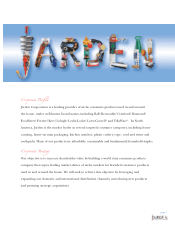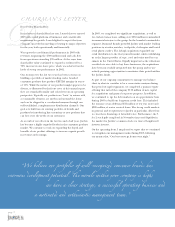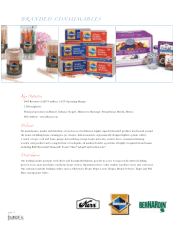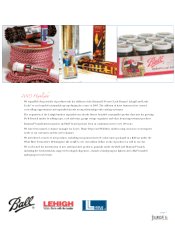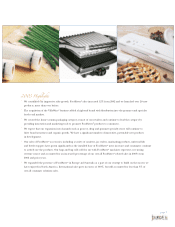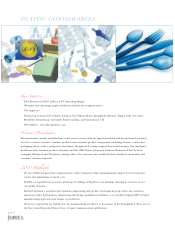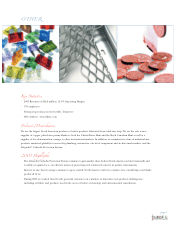Sunbeam 2003 Annual Report Download - page 13
Download and view the complete annual report
Please find page 13 of the 2003 Sunbeam annual report below. You can navigate through the pages in the report by either clicking on the pages listed below, or by using the keyword search tool below to find specific information within the annual report.
Jarden Corporation
Selected Financial Data (continued)
As of December 31,
2003
(a) (b)
2002
(c) (d)
2001
(e)
2000
(f)
1999
(g)
(dollars in thousands)
Balance Sheet Data:
Cash and cash equivalents ................... $125,400 $ 56,779 $ 6,376 $ 3,303 $ 17,394
Working capital ........................... 242,039 101,557 8,035 22,975 54,611
Total assets ............................... 759,674 366,765 162,234 310,429 340,364
Total debt ................................ 387,382 216,955 84,875 137,060 140,761
Total stockholders’ equity ................... 249,905 76,764 35,129 118,221 123,025
(a) 2003 includes a non-cash restricted stock charge of $21.8 million. Adjusting for the non-cash restricted stock charge, the
Company’s diluted earnings per share for 2003 would have been $1.91. Diluted earnings per share, excluding the non-cash
restricted stock charge is a non-GAAP financial measure and it is presented in this Form 10-K because it is a basis upon which
our management has assessed its financial performance in 2003. Additionally, the Company’s credit agreement has provided
for the non-cash restricted stock charge to be excluded in calculations used for determining whether the Company is in
compliance with certain credit agreement covenants. This calculation is a measure of the Company’s performance that is not
required by, or presented in accordance with, GAAP. As such it should not be considered as an alternative to diluted earnings
per share in accordance with GAAP. A reconciliation of the calculation of diluted earnings per share, excluding the non-cash
restricted stock charge, is presented below.
(b) The results of Diamond Brands and Lehigh are included from February 1, 2003 and September 2, 2003, respectively.
(c) The results of Tilia are included from April 1, 2002.
(d) 2002 includes a net release of a $4.4 million tax valuation allowance. Adjusting for the net release of the valuation allowance,
the Company’s diluted earnings per share for 2002 would have been $1.48. Diluted earnings per share, excluding the net
release of the valuation allowance is a non-GAAP financial measure and it is presented in this Form 10-K because it is a basis
upon which our management has assessed its financial performance in 2002. This calculation is a measure of the Company’s
performance that is not required by, or presented in accordance with, GAAP. As such it should not be considered as an
alternative to diluted earnings per share in accordance with GAAP. A reconciliation of the calculation of diluted earnings per
share, excluding the net release of the valuation allowance, is presented below.
(e) 2001 includes a $121.1 million pretax loss on the sale of thermoforming assets, a $2.3 million pretax charge associated with
corporate restructuring, a $1.4 million pretax loss on the sale of the Company’s interest in Microlin, LLC, $2.6 million of
pretax separation costs related to the management reorganization, $1.4 million of pretax costs to evaluate strategic options,
$1.4 million of pretax costs to exit facilities, a $2.4 million pretax charge for stock option compensation, $4.1 million of
pretax income associated with the discharge of deferred compensation obligations and a $1.0 million pretax gain related to
an insurance recovery.
(f) 2000 includes $1.6 million of pretax income associated with the reduction in long-term performance-based compensation,
$1.4 million in pretax litigation charges, net of recoveries and $0.6 million of pretax costs to evaluate strategic options.
(g) 1999 includes a $19.7 million pretax gain on the sale of the plastic packaging product line and a $2.3 million pretax charge to
exit a plastic thermoforming facility.
(h) Special charges and reorganization expenses, net were comprised of costs to evaluate strategic options, discharge of deferred
compensation obligations, separation costs for former officers, stock option compensation, corporate restructuring costs,
costs to exit facilities, reduction of long-term performance based compensation, litigation charges and items related to our
divested thermoforming operations.
(i) Pursuant to our adoption of SFAS No. 145, results for the year ended December 31, 1999 have been restated to give effect to
the reclassification of $1.6 million ($1.0 million, net of taxes) arising from the early extinguishment of debt previously
presented as an extraordinary item.
(j) All earnings per share amounts have been adjusted to give effect to a 3-for-2 split of our outstanding shares of common stock
that was effected during the fourth quarter of 2003.
(k) For the year ended December 31, 2003, EBITDA includes a non-cash restricted stock charge of $21.8 million. For the year
ended December 31, 2001, EBITDA includes a $122.9 million loss on divestiture of assets and product lines. EBITDA, a non-
GAAP financial measure, is presented in this Form 10-K because the Company’s credit facility and senior subordinated notes
contain financial and other covenants which are based on or refer to the Company’s EBITDA. Additionally, EBITDA is a basis
upon which our management assesses financial performance and we believe it is frequently used by securities analysts,
investors and other interested parties in measuring the operating performance and creditworthiness of companies with
comparable market capitalization to the Company, many of which present EBITDA when reporting their results.
Furthermore, EBITDA is one of the factors used to determine the total amount of bonuses available to be awarded to
executive officers and other employees. EBITDA is widely used by the Company to evaluate potential acquisition candidates.
While EBITDA is frequently used as a measure of operations and the ability to meet debt service requirements, it is not
necessarily comparable to other similarly titled captions of other companies due to potential inconsistencies in the method of
calculation. Because of these limitations, EBITDA should not be considered a primary measure of the Company’s
performance and should be reviewed in conjunction with, and not as substitute for, financial measurements prepared in
accordance with GAAP that are presented in this Form 10-K. A reconciliation of the calculation of EBITDA, is presented
below.
(l) For the year ended December 31, 2002, cash flows from operations included $38.6 million of income tax refunds resulting
primarily from the 2001 loss on divestiture of assets.
page 11


